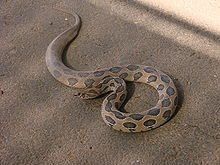Daboia
Daboia is an Old World venomous vipers. It was named after Patrick Russell (1726-1805). Patrick Russell was a Scottish
| Daboia | |
|---|---|

| |
| A Russel Viper in Pune, India | |
| Scientific classification | |
| Kingdom: | |
| Phylum: | |
| Subphylum: | |
| Class: | |
| Order: | |
| Suborder: | |
| Family: | |
| Subfamily: | |
| Genus: | Daboia
|
| Species: | D. russelii
|
herpetologist, who studied many Indian snakes. The Russell's Viper is one of the four most venomous snakes in India, and it causes the most deaths of all the venomous snakes.
This article does not have any sources. (May 2022) |
Description
changeRussell's vipers can grow up to the length of 166 centimeters (5.5 ft), but they are usually around the length of 120 centimeters (4 ft). The Russell's viper is usually dark yellow or brown in colour with many black spots. The viper is found in Asia.
Russell's Viper is found in open grassy and bushy areas, farmlands, coastal lowlands, plains and hills.
Behavior
changeThe Russell's Viper is Terrestrial (lives on the ground) and is usually nocturnal, but in cool weathers it is diurnal. When threaten it raises its head and makes a hissing noise which is said to be louder than other snakes. Their bite may sometimes be a simple snap, or sometimes the jaws hang on to the enemy for a few seconds. Adults are said to be slow and sluggish but when disturbed they become aggressive. Since of its aggressiveness and venom many animals and people are scared of this snake. That is why another snake, Rough-scaled Sand Boa, mimics the color pattern of the Russell's Viper so it looks like the Russell's Viper, but it is actually harmless. Adult's venom glands hold around 21–268 mg of venom, while young one's venom glands hold around 8–79 mg of venom.
Feeding
changeThe Russell's Viper eats rodents such as rats, mice, and squirrels, land crabs, lizards, shrews, scorpions and other arthropods. Young Russell's Vipers are said to be cannibals, meaning they eat each other.
Reproduction
changeThe Russell's Viper is viviparous: they give live birth. They mate early in the year and a female is pregnant for around six months before giving birth to her young in May to November, but usually in June or July. A female gives birth to around 20-40 young at a time, and the young are around 215-260 millimeters long when they are born. A Russell's Viper becomes mature after around 2–3 years.
Subspecies
changeNot including the nominate subspecies, the Indian Russell's Viper (D. r. russelii), there is only one subspecies, the Eastern Russell's Viper (D. r. siamensis).